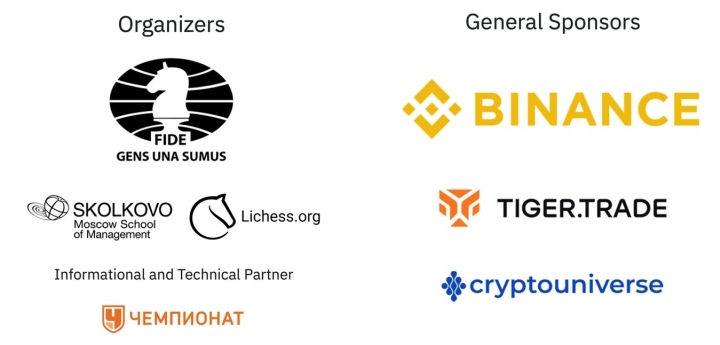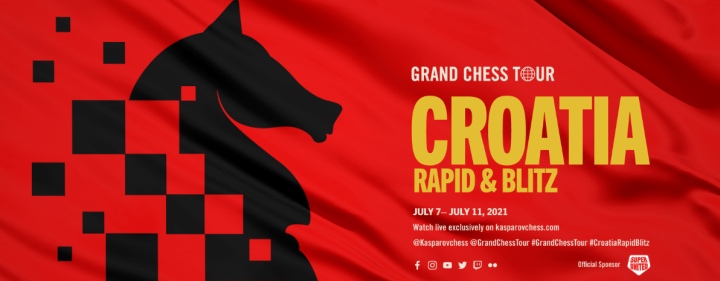FIDE Binance Business Schools Super Cup 2021 gets underway

The FIDE Binance Business Schools Super Cup, the first online team tournament for business schools, kicked off on July 9 on Lichess. The event together amateur chess players, the graduates from the world’s elite business schools. The event is supported by Binance — the world’s leading blockchain ecosystem, Tiger.Trade — an innovative software package for securities and cryptocurrency traders, CryptoUniverse — one of the largest mining platforms in the world. 32 teams from Russia, USA, Canada, India, Mexico, Switzerland, England, Scotland, Philippines, Bangladesh, Zambia and Fiji will battle over three days to determine the winner that will get the Winner’s Cup and the title of the Business Schools Super Cup Champion 2021. A tense battle unfolded from the very start. In group А the team of Mulungushi University (Zambia) with 12.5 points took the lead, the Finance University under the Government of Russia (Russia) is a half-point behind whereas Shri Ram College of Commerce (India) is third in the current standings with 11.5 points. The group B leader is MIPT Business School (Russia) is sitting on 16.0 points. It is followed by MGIMO (Russia) (14 points) and Daffodil International University (Bangladesh) (8 points). University of Toronto (Canada) (14 points), Moscow School of Management SKOLKOVO 1 (Russia) (12.5 points) and Adam Smith Business School (Scotland) (11.5 points) occupy top-3 positions in group C. In group D the current leader is Perm State National Research University (Russia) that netted 14 points after Day 1. The Russian Presidential Academy of National Economy and Public Administration (RANEPA) with 13.5 points is a close second, while Higher School of Economics (Russia) is third (12 points). Before the start of the games, FIDE President Arkady Dvorkovich shared his support for the tournament and talked about the plans to make a full-scale world championship among business schools in the future. The FIDE President Arkady Dvorkovich: “It is important in such informal or semi-formal competitions to enjoy the game, meet new friends, new colleagues, and spark new ideas. And, of course, to plan a return to the official competitions. We expect that after this first experience of the tournament between business schools, we will be able to get closer to hosting the official world championship among business schools”. The FIDE Binance Business Schools Super Cup will last for 2 more days. On Saturday, July 10, each team will play three more games. After that, the strongest will advance to the playoffs. The FIDE Binance Business Schools Super Cup 2021 Champion will be announced this Sunday, July 11. The daily online broadcasts streamed from the Moscow School of Management SKOLKOVO are available on the official FIDE channels on Youtube, VK and Twitch: Youtube: https://www.youtube.com/user/fidechannelTwitch: https://www.twitch.tv/fide_chessVK: https://vk.com/fide About the sponsors: Binance is the world’s leading blockchain ecosystem and cryptocurrency infrastructure provider with a financial product suite that includes the largest digital asset exchange by volume. Trusted by millions worldwide, the Binance platform is dedicated to increasing the freedom of money for users, and features an unmatched portfolio of crypto products and offerings, including: trading and finance, education, data and research, social good, investment and incubation, decentralization and infrastructure solutions, and more. TigerTrade is an innovative software package for securities and cryptocurrency traders. TigerTrade company has over five years of software development experience in the trading field, and in this short time, TigerTrade has managed to earn the full trust of its loyal customer. More than 15,000 active users worldwide with a daily volume of 100 mil USD have already chosen TigerTrade for analysis and trading. TigerTrade provides intuitive interactive visualization of market data, 30+ components for cluster analysis, flexible, customizable workspace with the support of a few monitors, and other tools and features. CryptoUniverse.io is one of the largest mining platforms in the world, offering power and equipment for cryptocurrency mining since 2017. Registered in Estonia under EU law, it owns one of the biggest data centers in CIS, located in the Republic of Karelia. Its overall capacity is 120 MW, with electricity coming from a private hydroelectric power plant, leaving no carbon footprint. The company is glad to participate in the Cup because chess and IT management have much in common in terms of considering various moves and outcomes. About the organizers: Moscow School of Management SKOLKOVO is one of the leading business schools in Russia and the post-Soviet states established in 2006 by the business community. In 2020 it became No.1 in Eastern Europe in terms of quality of corporate programmes according to the Financial Times ranking. The School was awarded the EQUIS EFMD accreditation – one of the most prestigious international accreditations granted to 1% of the leading international business schools. The idea of the Cup belongs to its alumni: Oxana Kosteniuk, the president of the SKOLKOVO Chess Club, and its members: Sergey Raytsev, Tigran Mamikonian, Alexey Maiorov and Yuriy Mordvin. Lichess is a completely free, open-source chess platform — exclusively powered by volunteers and donations. Today, Lichess users play more than 3 million games every day. Lichess is one of the most popular chess websites in the world while remaining 100% free. Despite starting out as just a chessboard, Lichess now has a wide variety of features to meet the needs of the internet chess community: play, learn, events, community. Championat.com is the leading sports digital media in Russia and CIS. We are in the TOP-7 of Similar Web in category “sports media in the world”. More than 36 million unique visitors enjoyed Championat.com in May 2021.
Nepomniachtchi in front after rapid

Day three, and the last day of the rapid portion of the GCT Croatia Grand Chess Tour brought another dramatic day of chess. It may have seemed like a quiet day as there were only three decisive games. However, there were many hard-fought games with plenty of action making it a thrilling day of missed opportunities and excitement for the spectators. Round 7 The first game to finish in round seven was between Ivan Saric against Shakhriyar Mamedyarov. They played a theoretical line of the Open Spanish where Black was able to equalize. Although activated his rook on the 7th rank, there was no way to continue putting pressure and the players agreed on a draw after a threefold repetition. Although the Meran variation in the Semi-Slav is known to be a solid defense for Black, the game between Alexander Grischuk against Anton Korobov showed otherwise as Grischuk went for an e4-e5 push to take away Black’s king defender and tried focusing on a king-side attack. Despite a two-piece sacrifice 16. Nxe6 followed by 17. Bxg7, White didn’t have enough pieces in the attack, and the game ended in a perpetual. The game between Anish Giri and Ian Nepomniachtchi was a highlight for the fans given the leader’s loss in yesterday’s last round. For many players, it is often difficult to come back after a tough loss, but Ian kept his calm. They opted for a Closed Catalan where most pieces got traded off into a rook and knight versus a rook and bishop endgame. Black had a passed d-pawn, but neither player had a way to make progress and the opponents agreed on a draw. The talented Dutch Grandmaster Jorden Van Forest surprised the top French player Maxime Vachier-Lagrave with 10.h3N in the Najdorf Variation of the Sicillian (10. Be2 is a standard continuation in that position) and within the next few moves the position was certainly more favorable for White. When MVL tried the typical 22…d5 to equalize, he failed to realize that 23. Nc5! followed by the capture of his bishop in b7 and f4-e5 would have given White a huge advantage. Jorden missed that opportunity and a few moves later went for greedy 26.exd5?? To win a pawn, he gave up the advantage after the beautiful 26…Nd3, which allowed Black to trade pieces into an equal endgame. The game didn’t end there though as the tables turned when White played 33. Re4? (instead of 33. d6) allowing Black to gain activity on the back rank. Black’s activity was so strong that the two-pawn deficit wasn’t even important. It seemed that MVL was in control and ready to convert, but Jorden fought until the end. He found a way to give up an exchange and ultimately created an unassailable fortress. Another game that kept the viewers on the edge of their seats was the one between Jan-Krzysztof Duda and Viswanathan Anand. After getting an equal position from the Berlin Defense, Anand started pushing for the advantage. He attacked White’s center with f5 and upon being allowed to capture in e4 he found a way to trade into a better endgame with 30…Bxb4! giving up two pieces for a rook and two pawns. Although those pawns seemed menacing, White found a way to keep them from advancing. After trading a pair of rooks, Anand activated his remaining rook active and attack White’s pawn weaknesses on the other side of the board. Unfortunately for Anand, there were several occasions where only moves were winning. His last miss was 65…h3??. He pushed the pawn too soon allowing White to trade his g-pawn for it and save the endgame. Instead, he had to give a few checks to push White’s king either back which would have allowed for his own king to advance, or forward which would have kept it away from the h-pawn. With little time on the clock, only the computer could have probably found the best continuation, so the game only ended in a draw. Round 8 The first game to finish in round eight was the one between Ian Nepomniachtchi and Jorden Van Foreest. The opening choice of the Exchange Variation of the Slav suggested a quiet game, but Ian had some tricks up his sleeve and focused on the weakening of Black’s king-side with 10. f4 and a typical bishop sacrifice 17.Bxg6. Unfortunately for him, he did not have enough resources to continue the attack and had to concede a three-fold repetition. The game between Anton Korobov and Maxime Vachier-Lagrave was a hard-fought duel in the Najdorf Sicilian, where Black gave up his a-pawn for piece activity. Despite the extra pawn, a bishop versus a knight and more space, White failed to find a way to push his majority on the queen-side without trading into a rook endgame. Once arrived in the rook endgame, Black kept his rook active and he was never in trouble to hold the game to a draw. Anish Giri and Shakhriyar Mamedyarov played a theoretical line in the Gruenfeld Defense where many of the moves seemed forced to keep the balance. They traded into an opposite-color bishop endgame in which they agreed on a draw. Viswanathan Anand had some positional advantage after the opening in his game against Ivan Saric. After 13…0-0 it seemed that White could have put some pressure on Black’s king with 14. Bh6 followed by Rae1 and some potential rook-lift as an attempt to keep the initiative and delay Black a little longer from the development of his bishop in c8. After 14. Qd4, Black was able to complete his development, trade his central weaknesses. The game was well played until the endgame where the players agreed on a draw in a rook and three pawn endgame on each side. The most complicated game of the round was the encounter between Alexander Grischuk and Jan-Krzysztof Duda. The Najdorf Defense was the opening choice of these two players and after the end of the theory, White had the opportunity to win the b7-pawn, but chose not to do so. Instead, Grischuk went for 22. b3?

